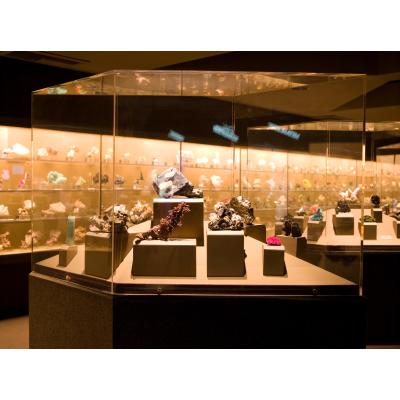
Posted in: Exhibitions
 The Gem and Mineral Hall in LA County showcases one of the world's most valuable and extensive collection of gemstones and minerals. Photo courtesy of the Natural History Museum of Los Angeles County.
The Gem and Mineral Hall at the Natural History Museum of Los Angeles County houses over 150,000 mineral specimens. Representing roughly half of the world's known mineral species, this collection is the second-largest mineral collection in the United States.
The Gem and Mineral Hall in LA County showcases one of the world's most valuable and extensive collection of gemstones and minerals. Photo courtesy of the Natural History Museum of Los Angeles County.
The Gem and Mineral Hall at the Natural History Museum of Los Angeles County houses over 150,000 mineral specimens. Representing roughly half of the world's known mineral species, this collection is the second-largest mineral collection in the United States.
The Gem and Mineral Hall
Visitors to the Natural History Museum in Los Angeles enter side-by-side, hushed, and nearly sacred galleries. Glass cases and lightboxes line the walls, and islands of spotlighted vitrines fill the central spaces. Roughly 2,000 specimens delight the eyes in these spotlighted glass display cases. In addition to raw mineral specimens, the Gem and Mineral Hall also showcases precious and semi-precious gemstones, rocks, ores, and meteorites. In fact, the museum houses more than 50 meteorites. Several of these meteorites date back to 4.6 million years. That's as old as our solar system.What Meteorites Tell Us About Our Solar System
Cosmologists believe that our sun and the planets of our solar system formed out of space dust and debris that swirled around in the vast depths of space. The unique forces at work in space brought this dust and debris together to form clumps. Some of these clumps emerged as our gigantic sun and planets. This process also resulted in smaller space bodies called meteoroids. These space rocks sometimes fall to earth in a flash of light. As they come crashing through the earth's atmosphere, these meteoroids catch on fire and fall flaming to the ground as meteors. Scientists call the cooled space chunks left behind after impact meteorites. These leftover bits of space rock tell important stories about Earth's early beginnings. In particular, they teach us which of Earth's minerals originated from space, versus those that emerged from the inner workings of our planet. At the present time, geologists and mineralogists have identified more than 5,000 minerals on earth. Of these, they believe only 60 originated from space. Diamonds, magnesium, silicon, nickel, and iron originated in space. In fact, one of the rarest type of meteorite, called a pallasite meteorite, consists primarily of iron and nickel, with flecks of olivine (magnesium, silicon, iron, and oxygen).See and Touch
The largest meteorite on display in the Gem and Mineral Hall fell to earth about 50,000 years ago. Called the Canyon Diablo Meteorite, it represents one of a number of chunks that remain after a huge asteroid hit the earth. This particular asteroid impact created the Barringer Crater in Arizona. While most of the specimens in the galleries remain safely behind glass, the Canyon Diablo Meteorite stands open to the air, and to visitors. Museum curators actually encourage people to see and touch this ancient space rock. The museum offers other see-and-touch opportunities, as well. Indeed, a slab of jadeite weighing hundreds of pounds stands in plain view. Visitors are encouraged to place their hands upon the gem-quality specimen. Not surprisingly, the Mineral Hall also includes over 300 pounds of gold found in California. This includes the largest gold nugget ever found - the Mojave Nugget, which weighs more than 10 pounds!! Truly an immersive experience, the Gem and Mineral Hall at the Natural History Museum of LA County offers visitors an incredible opportunity. To plan your trip, I invite you to visit their website. ~Angela Magnotti Andrews5 years ago
26 view(s) 